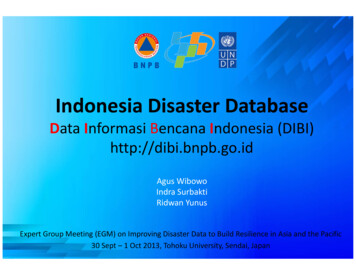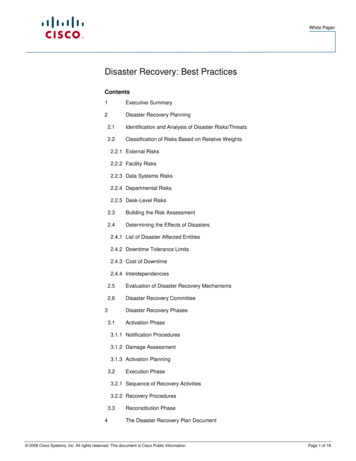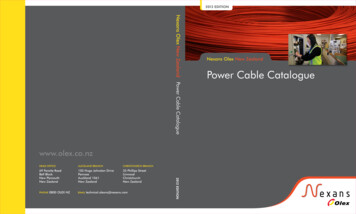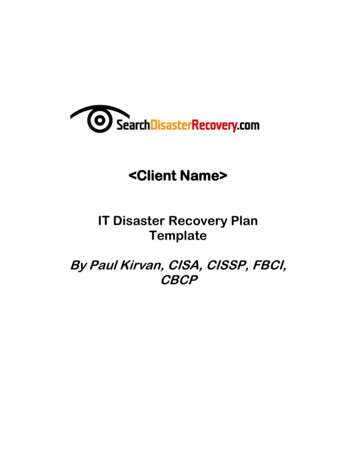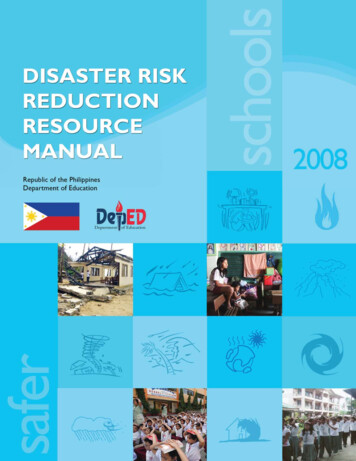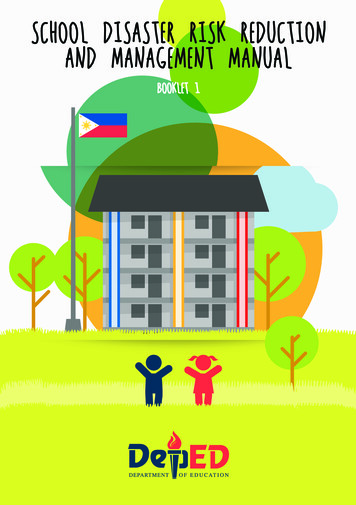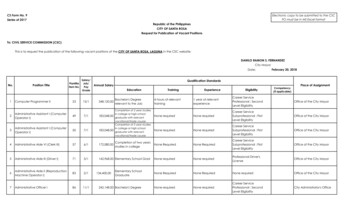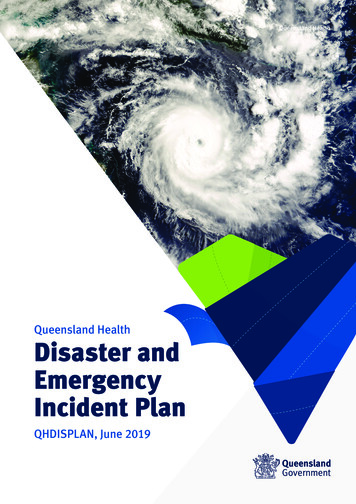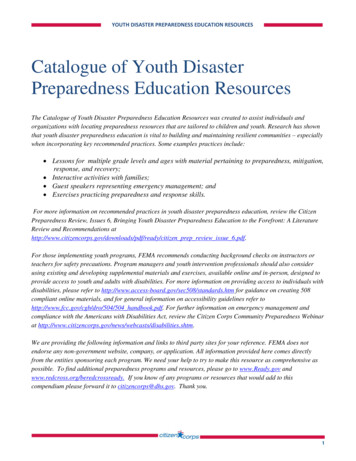
Transcription
YOUTH DISASTER PREPAREDNESS EDUCATION RESOURCESCatalogue of Youth DisasterPreparedness Education ResourcesThe Catalogue of Youth Disaster Preparedness Education Resources was created to assist individuals andorganizations with locating preparedness resources that are tailored to children and youth. Research has shownthat youth disaster preparedness education is vital to building and maintaining resilient communities – especiallywhen incorporating key recommended practices. Some examples practices include:Lessons for multiple grade levels and ages with material pertaining to preparedness, mitigation,response, and recovery;Interactive activities with families;Guest speakers representing emergency management; andExercises practicing preparedness and response skills.For more information on recommended practices in youth disaster preparedness education, review the CitizenPreparedness Review, Issues 6, Bringing Youth Disaster Preparedness Education to the Forefront: A LiteratureReview and Recommendations citizen prep review issue 6.pdf.For those implementing youth programs, FEMA recommends conducting background checks on instructors orteachers for safety precautions. Program managers and youth intervention professionals should also considerusing existing and developing supplemental materials and exercises, available online and in-person, designed toprovide access to youth and adults with disabilities. For more information on providing access to individuals withdisabilities, please refer to http://www.access-board.gov/sec508/standards.htm for guidance on creating 508compliant online materials, and for general information on accessibility guidelines refer tohttp://www.fcc.gov/cgb/dro/504/504 handbook.pdf. For further information on emergency management andcompliance with the Americans with Disabilities Act, review the Citizen Corps Community Preparedness Webinarat ties.shtm.We are providing the following information and links to third party sites for your reference. FEMA does notendorse any non-government website, company, or application. All information provided here comes directlyfrom the entities sponsoring each program. We need your help to try to make this resource as comprehensive aspossible. To find additional preparedness programs and resources, please go to www.Ready.gov andwww.redcross.org/beredcrossready. If you know of any programs or resources that would add to thiscompendium please forward it to citizencorps@dhs.gov. Thank you.1
YOUTH DISASTER PREPAREDNESS EDUCATION RESOURCESSummary of Youth Disaster Preparedness Programs9-1-1 for Kids, Pre-K—Adult (Ages 4-Adult)4Alabama: Be Ready Camp, 6th Grade (Ages 11-12)4American Red Cross: Masters of Disaster, K-8th Grade (Ages 5-14)4American Red Cross Storm: The Dorm, Ages 18-215American Red Cross: Youth Disaster Action Team (YDAT), Ages13-175Boy Scouts: Emergency Preparedness Merit Badge, Ages 11-175Canadian Red Cross: Bug Out! Get the Facts on Germs, K-8th Grade (Ages 5-14)6Civil Air Patrol: Teen Cadet Program, Ages 12–186Colorado’s Responding to Emergency and Disasters with Youth (C-READY),Ages 13-186Corporation for National and Community Service: Learn and Serve America, K–Adult(Ages 5-Adult)7Department of Education: Service Learning and Volunteer Opportunities, K–Adult(Ages 5-Adult)7Delaware School Disaster Preparedness Program, 6th–12th Grade (Ages 11-18)7Discovery Education: Ready Classroom, K–8th Grade (Ages 5-14)8DoSomething.org: Disaster Response and Relief, Ages 13–158Environmental Protection Agency, K–12th Grade (Ages 5-18)8Extension Disaster Education Network, 1st–5th Grade (Ages 6-11)9FEMA for Kids, K–6th Grade (Ages 5-12)9FEMA: Teen Community Emergency Response Team (CERT) Training,7th–12th Grade (Ages 12-18)9FEMA: Ready Kids, Ages 8–1210FEMA: Student Tools for Emergency Planning, 4th–5th Grade (Ages 9-11)10Fire Corps, K–Adult (Ages 5-Adult)10Firefacts.org, K–6th Grade (Ages 5-12)10Florida: Kids Get a Plan, K-5th Grade and 6th (Ages 5-18)11Girl Scouts: “Be Prepared!” Emergency Preparedness Patch, K—12th Grade(Ages 5-18)11Home Fire Sprinkler Coalition: Sprinkler Smarts, K–8th Grade (Ages 5-14)11Home Safety Council: Code Red Rover, K–1st Grade (Ages 5-7)11stHome Safety Council: Get Ready with Freddie!, K–1 Grade (Ages 5-7)11Illinois: Ready Illinois School Challenge, Middle School, High School, and College(Ages 11-22)12Indiana: Operation Safeguard12Learning for Life: Exploring—Law Enforcement, Ages 14–2112Medical Reserve Corps, K–Adult (Ages 5-Adult)13Michigan: American Red Cross Storm - Safe On My Own, Ages 9-1113National Association for Search and Rescue: Hug-a-Tree and Survive Program,2nd–5th Grade (Ages 7-11)13National Crime Prevention Council: McGruff Club, 1st–5th Grade (Ages 6-11)14National Crime Prevention Council: Teens, Crime, and the Community,2
YOUTH DISASTER PREPAREDNESS EDUCATION RESOURCES7th–12th Grade (Ages 12-18)National Fire Protection Association: Sparky, K–6th Grade (Ages 5-12)National Fire Protection Association: Risk Watch—Natural Disasters,Pre-K–8th Grade (Ages 4-14)National Oceanic and Atmospheric Administration: Weather for Kids and Students,K–12th Grade (Ages 5-18)National Volunteer Fire Council: National Junior Firefighter Program,K–12th Grade (Ages 5-18)New York City Office of Emergency Management: Ready New York for Kids,K–5th Grade (Ages 5-11)New Zealand Ministry of Civil Defence: What’s the Plan, Stan?, Ages 7–12Points of Light Institute: Youth & Family Programs, K–12th Grade (Ages 5-18)Ready Houston, K–5th Grade (Ages 5-11)Save the Children: Resilient and Ready Program,,K-6th Grade (Ages 5-12)Serve DC: Commander Ready Program, K–8th Grade (Ages 5-14)Sesame Workshop: Let’s Get Ready! Planning Together for Emergencies,Pre-K (Ages 4-5)ShelterBox: Young ShelterBox USA ProgramTexas: Teen Advocates for Community Safety (TACS), Ages 14-19United States Power Squadrons: USPS 4 Kids, K–8th Grade (Ages 5-14)USA on Watch, K–Adult (Ages 5-14)Volunteers in Police Service: Youth-Related Activities, K–12th Grade (Ages 5-18)Wisconsin: Center for School, Youth and Citizen Preparedness, Ages 13–18141414151515151616161717171818181819Other Publications and ResourcesAmerican Academy of Pediatrics: Family Readiness Kit, 2 nd EditionAmerican College of Emergency Physicians: Disaster HeroAmerican Red Cross: Be Red Cross Ready Safety Series Volume 4:A Family Guide to First Aid and Emergency PreparednessAmerican Red Cross: SeeMore’s Playhouse VideoAmerican Red Cross and FEMA: Helping Children Cope with DisasterAmerican Red Cross and FEMA: Disaster Preparedness Coloring BookAmerican Red Cross and FEMA: Ready Set.Prepare Activity BookEffective Education for Disaster Risk Reduction – Teacher NetworkNational Association of Child Care Resource and Referral Agencies:Preparing for Disaster – the Parent ViewNSF (National Sanitation Foundation) International: Scrub ClubREMS Technical Assistance CenterSesame Street: Let’s Get ReadyUnited Nations International Strategy for Disaster Reduction: Stop Disasters!191920202020212121212222223
YOUTH DISASTER PREPAREDNESS EDUCATION RESOURCES9-1-1 for KidsPre-K—Adult (Ages 4-Adult)http://www.911forkids.com9-1-1 for Kids is the official public education organization for law enforcement agencies, fire departments,emergency medical response and 9-1-1 communication centers for the U.S., Canada and the Cayman Islands; allcountries where "9-1-1" is the universal emergency response phone number. The 9-1-1 for Kids site offersinformation and links for training materials for public safety officials, community groups, parents, teachers andchildren. Instructional materials include: the "Presenter's Pak" (featuring ―The Great 9-1-1 Adventure‖ video and"Presenter's Manual & Lesson Plan" ); "Classroom Pak" (serves 25 students: student activity sheets, stickers, bookmarks, Student Completion Certificates, classroom poster); and support teaching materials (e.g. coloring books,emergency wallet cards, pencils, erasers, rulers, zipper pulls, goodie bags, apparel, 9-1-1 heroes awards supplies).The 9-1-1 Local Heroes program aims to bring awareness to exemplary dispatchers and 9-1-1 youth heroes.The 9-1-1 Local Heroes Medal of Honor, is bestowed on a young person who distinguishes himself/herself bygallantry and intrepidity calling 9-1-1 to help save a life or property, or to report a crime. This award is alsopresented to the 9-1-1 dispatcher/call taker who processed the call, and dispatched the appropriate emergencyresponse help. Award nominations, event support and supplies are all available through www.911forkids.com.Alabama: Be Ready Camp6th Grade (Ages 11-12)http://www.bereadycamp.orgBe Ready Camp was created to teach Alabama’s 6th graders about disaster preparedness and response. Topicsrange from fire safety to light search and rescue. The camp culminates with a mock disaster, where the camperswork side by side with first responders to respond to a simulated plane crash. Using the skills learned during theweek, such as medical triage and light search and rescue, the 6th graders are able to triage and prioritize disastervictims and move them out of harm’s way. In addition, the campers are able to plan out their response by workingtogether as a team by efficiently delegating tasks to the suitable person and maintaining strong communicationwith each other. All Alabama residents entering the 5th grade are eligible to attend and participants are chosenthrough a competitive application process.American Red Cross: Masters of DisasterK-8th Grade (Ages 5-14)http://www.redcross.org/disaster/masters/The American Red Cross Masters of Disaster curriculum is centered on a series of ready-to-go lesson plans thathelp organizations educate youth about important disaster safety and preparedness information. Masters ofDisaster contains lessons, activities, and demonstrations on disaster-related topics that organizations canincorporate into daily or thematic programming. The curriculum is non-sequential, allowing organizers to choosethe lesson plans that best fit into their programming. The Masters of Disaster curriculum materials meet nationaleducational standards and are specifically tailored for lower elementary (K–2), upper elementary (3–5) andmiddle school (6–8) classes.4
YOUTH DISASTER PREPAREDNESS EDUCATION RESOURCESThe education on essential preparedness skills that students receive through the Masters of Disaster program willcarry them through life. Lessons are enjoyable and interactive, ensuring that children are having fun whileinternalizing important life skills though building capabilities in Mathematics, Language Arts, Social Studies, andScience.All across the country, through The American Red Cross, young people are trained to become involved in manyareas of Red Cross Disaster Services, including community disaster education, disaster preparation in their localcommunity, and disaster response through Red Cross disaster action teams and youth disaster corps. The RedCross conducts school-related activities, including fundraising, organizing blood drives, providing internationalassistance, and teaching disaster preparedness and HIV/AIDS prevention and awareness.American Red Cross Storm: The DormAges 18-21http://redcrossyouth.org/resourcesCollege age students can help their friends and prevent and prepare for disasters that could strike while they areaway from home. Red Cross Campus Clubs offer ―Storm the Dorm, Be Red Cross Ready‖ preparedness trainingon college campuses nationwide. This three hour interactive presentation helps students to identify hazards intheir area, dorm safety plans, and how to build an emergency kit.American Red Cross: Youth Disaster Action Team s.com/2008/09/ythindis.pdfYouth have been involved in disaster service with the American Red Cross since 1884. Today they can continuethis legacy of community disaster relief by becoming members of their local Youth disaster Action Team(YDAT). As a YDAT member youth build community awareness about local hazards; educate the communityabout how they can better prepare for, prevent and respond for disasters; and provide high-quality, timely andeffective disaster relief when a disaster strikes. To join the YDAT in your area contact your local American RedCross for orientation and disaster training opportunities.Boy Scouts: Emergency Preparedness Merit BadgeAges badges/emergencypreparedness.aspThe Boy Scout Emergency Preparedness Merit Badge includes learning skills for preparedness, response,recovery and mitigation for emergency situations ranging from home emergencies, camping accidents, naturaldisasters, boating accidents, and power plant accidents. The badge requirements also include developing plansand checklists and working with others to help them become prepared.5
YOUTH DISASTER PREPAREDNESS EDUCATION RESOURCESCanadian Red Cross: Bug Out! Get the Facts on GermsK-8th Grade (Ages t act 12 13e.pdfThis program is designed to help children (grades k-8), parents, teachers and caregivers learn about theimportance of illness prevention and control. It is a unique program that features in-class and at-home activitieson topics including how bacteria and viruses are spread, hand hygiene, cough and sneeze etiquette, when and whyto stay home when you are sick, immunization, and influenza pandemic preparedness.Civil Air Patrol: Teen Cadet ProgramAges htmThe U.S. Air Force Auxiliary, the Civil Air Patrol (CAP) runs a teen cadet program for youth aged 12-18. Cadetsfly, learn to lead, hike, camp, get in shape, and push themselves. The program features instruction in theprinciples of aviation and aerospace flight, and offers cadet encampments with activities in emergency services,engineering, technology, physical fitness, teambuilding, and flight training. The CAP Teen program can helpprepare youth for career in aviation, space, or the military. About 10% of the cadets at the U.S. Air ForceAcademy got their start in CAP. Cadets meet 2 hours per week and one Saturday per month, on average, and alsohave opportunities to attend leadership encampments, career academies, and international exchanges during thesummer.Colorado’s Responding to Emergency and Disasters with Youth (C-READY)Ages rado’s Responding to Emergency And Disasters with Youth (C-READY) program is coordinated by theCenter for School, Youth, and Citizen Preparedness, a non-profit organization working in collaboration withmany statewide and local organizations. Students will learn about their potential role in preparing for, respondingto, and recovering from an emergency situation, and have the opportunity to put what they’ve learned to use inmock disaster exercises throughout the week. The program has the goal of teaching over 100 students the skillsthey need to stabilize any injuries they may have suffered before moving on to assist others during and afteremergency situations until professionals arrive. Students will also learn to identify the hazards most likely tooccur and reduce potential hazards in and around the home and school. They will receive training in safety andinjury prevention, first aid, CPR, and the use of an automatic external defibrillator. The program also teachesyouth how to respond to natural and manmade disasters and develops their leadership skills to affect changethrough higher education after graduation. Youth will be encouraged to lead community prevention efforts,increase their interest in health and public safety careers, and volunteer in their communities through servicelearning projects.6
YOUTH DISASTER PREPAREDNESS EDUCATION RESOURCESC-READY is an adaptation of the Wisconsin READY Camp experience and will expand upon the Disaster ReadyTraining that has already been implemented by the Governor’s Office of Homeland Security and Ready Coloradofor middle and high school students.Corporation for National and Community Service: Learn and Serve AmericaK–Adult (Ages s/index.aspThe Corporation for National and Community Service includes Learn and Serve America, which allows childrento participate in service-learning activities, and offers a unique opportunity for them to get involved by combiningcommunity service projects with classroom learning. Service-learning engages students in the educationalprocess, using what they learn in the classroom to solve real-life problems. Learn and Serve America providesdirect and indirect support to K–12 schools, community groups and higher education institutions to facilitateservice-learning projects. SERVEnet allows volunteers to find opportunities in their communities.Department of Education: Service Learning and Volunteer OpportunitiesK–Adult (Ages e/list.jhtmlThe Department of Education’s website offers links to a number of resources and opportunities that youth can useto get involved in their communities. For example, through AmeriCorps, young volunteers can find nationalservice programs that provide opportunities to tutor and mentor youth, build affordable housing, teach computerskills, clean parks and streams, run after-school programs, and help communities respond to disasters.Delaware School Disaster Preparedness Program6th–12th Grade (Ages he Delaware Disaster Preparedness Program was developed by Delaware Citizen Corps, American Red Cross ofthe Delmarva Peninsula, Public Health Preparedness, Retired Senior Volunteer Program, and DelawareEmergency Management. The goal of the program is to present students with a common message about theimportance of preparing for all hazards. The program is delivered in schools by the Delaware State Police’sSchool Resource Officers and Youth Aid Officers. The initiative was first implemented in 2009 at the beginningof the school year, during National Preparedness Month. Currently, the program is composed of a series of fivevideos, classroom discussion guide, and covers a variety of topics, including ―Developing a Family Plan,‖―Making a Disaster Kit,‖ ―Shelter- in- Place,‖ and ―Evacuation Resources.‖7
YOUTH DISASTER PREPAREDNESS EDUCATION RESOURCESDiscovery Education: Ready ClassroomK–8th Grade (Ages #/mapIn 2009, Discovery Education launched Ready Classroom, an online educational curriculum program. Theprogram provides K-8 teachers with resources to integrate natural disaster preparedness information into theircurriculum. The online resource, www.discoveryeducation.com/readyclassroom, offers teachers activities, lessonplans and multimedia tools that teach students how natural disasters develop and inspires them to build their ownemergency preparedness plans with their families.DoSomething.org: Disaster Response and ReliefAges isaster Response And ReliefDoSomething.org is strives to help young people support a range of different issues. By utilizing the web,television, mobile, and pop culture, DoSomething.org aims to inspire, empower and celebrate a generation ofteenagers who recognize the need to do something, believe in their ability to get it done, and then take action.Their website provides information on recent disasters, facts on disaster response and relief, and tips on how totake action with their families and communities to become more prepared for disasters. The organization alsosends text alerts to inform teens on how they can take action in response to a recent disaster.Environmental Protection AgencyK–12th Grade (Ages 5-18)http://www.epa.gov/kidsThe Environmental Protection Agency (EPA) offers opportunities for children and youth are broken into threetiers, organized by age. The first is the Environmental Kids Club, for ages 4–10. This program teaches youngerchildren about their environment, and focuses on specific topics including plants and animals, air, water, garbageand recycling, hazardous chemical spills, and extreme weather events. The second is the EPA Student Center,which is targeted towards children ages 10–14. This program features environmental club projects, assistancewith careers, internships and scholarships, environmental youth awards, and activities. Students can learn aboutecosystems, human health, waste and recycling, chemical spills, water, conservation, air, weather, and otherenvironmental basics. The final tier is the High School Environmental Center, which features summer studentemployment opportunities and offers the same avenues for involvement as the Student Center. The High SchoolEnvironmental Center also offers an environmental dictionary, information on environmental laws, and access tothe EPA newsroom, publications, and other information sources. The High School Environmental Center featuresinformation on issues related to air, water, waste and recycling, ecosystems, conservation, health and safety,extreme weather, and community environmental issues.8
YOUTH DISASTER PREPAREDNESS EDUCATION RESOURCESExtension Disaster Education Network1st–5th Grade (Ages 1104.Cain.disasterdave.htmlThe Extension Disaster Education Network (EDEN) links Extension educators from across the U.S. and variousdisciplines, enabling them to use and share resources to reduce the impact of disasters. From food safety to fieldsafety, from physical to psychological, and from government to community development, EDEN has resourcesyou can use.One resource developed by EDEN member Purdue University Extension is "Disaster Dave's Misadventures," aneducational computer activity. The focus of the program is to teach disaster-readiness skills in a fun andentertaining fashion. This is done through Disaster Dave, whom students help navigate through a variety ofnatural and other disasters. From blizzards to tornadoes, from hazardous materials spills to national securityemergencies, Disaster Dave's fictional community is either destroyed or spared, depending upon the skills andknowledge of the player.FEMA for KidsK–6th Grade (Ages 5-12)http://www.fema.gov/kids/The FEMA for Kids website features disaster-related games, quizzes, stories, photos, and cartoons, and provideschildren with the opportunity to earn a Disaster Action Kid certification. The site also offers information forchildren, parents, and teachers on preparing for disasters and coping with the aftermath, including guidance onhow to create a supply kit and disaster plan. The site offers access to an email server which regularly providesdisaster news and information. Kids are also able to get information on ongoing disasters all over the country viaan interactive map. Specific information is provided on preparing for and reacting to hurricanes, tornadoes,earthquakes, volcanoes, floods, tsunamis, thunderstorms, wildfires, winter storms, and terrorism.FEMA: Teen Community Emergency Response Team (CERT) Training7th–12th Grade (Ages 12-18)http://www.teencert.orgTeen CERT provides basic CERT training to students in their high schools. The program gives studentsemergency and leadership skills, creates an emergency response asset for schools, creates an avenue to deliver thepreparedness message to teens’ families and parents, creates a culture of preparedness among tomorrow’scommunity leaders, and promotes connection to local sponsoring agencies, including the fire department, lawenforcement, and emergency management. Teen CERT currently operates in over 100 school districts nationwide.9
YOUTH DISASTER PREPAREDNESS EDUCATION RESOURCESFEMA: Ready KidsAges 8–12http://www.ready.gov/kids/home.htmlReady Kids is a component of the Department of Homeland Security Ready.gov initiative and provides guidanceon creating an emergency preparedness kit and plan, as well as specific information on tornadoes, earthquakes,fire emergencies, flooding, tsunamis, and hurricanes, and general information on terrorism. Kids are able to earn acertification from Readiness U, and are offered disaster-related games, quizzes, and comic strips. The site alsofeatures information for parents and teachers targeted towards emergency planning and coping with disaster andits aftermath.FEMA: Student Tools for Emergency Planning4th–5th Grade (Ages 9-11)http://www.riema.ri.gov/step/Student Tools for Emergency Planning (STEP) is designed to teach 5 th graders what to do in emergencysituations, and how to create emergency kits and develop family communication plans. STEP requires only 1hour of instructional time during the school year, but offers up to 15 hours of optional materials that align withnational and state standards. Instructional materials for teachers include student handouts, instructional booklets,and ―The Adventures of the Disaster Dudes‖ video. This video shows students playing a game based on disasterpreparedness and is accompanied by discussion points for teachers to cover after showing the video. The websiteincludes links for teachers (e.g., to sample letters to families and discussion topics), and students (e.g., a list ofemergency kit contents and family communication plan cards). There are links to supplemental materials, as well,including emergency role play scenarios and a student reading list.Fire CorpsK–Adult (Ages 5-Adult)http://www.firecorps.orgThe Fire Corps offers fire prevention and life-safety education and training for students to assist in emergencyresponse efforts at their schools and in their communities. The Corps asks its volunteers to teach youth about theirvital role in making communities safer, encouraging them to have pride in their country, gain an understanding oftheir civic duty, and accept personal responsibility for their well-being as an active member of the community.Firefacts.orgK–6th Grade (Ages 5-12)http://www.firefacts.orgFirefacts.org is an interactive website to teach fire safety to children in grades K though 6. The program featuresthe Fire Safety Learning System CD for use in schools, and activities for kids to complete on their own, includingcoloring books, word puzzles, and online games. There are also resources for parents and caregivers to promotefire safety and awareness in the home.10
YOUTH DISASTER PREPAREDNESS EDUCATION RESOURCESFlorida: Kids Get a PlanK-5th Grade and 6th (Ages 5-18)http://www.kidsgetaplan.com/Kids Get a Plan includes an individual set of tools and information for youth in grades kindergarten to fifth andthose in sixth grade and higher. Resources include activities, downloadable interactive stories, contests, resourcesfor parents and news on recent disasters.Girl Scouts: ―Be Prepared!‖ Emergency Preparedness PatchK—12th Grade (Ages 5-18)http://www.gscnc.org/dhs.htmlDeveloped in conjunction with FEMA’s Citizen Corps, the Girl Scout Council of the Nation’s Capital created the―Be Prepared!‖ Emergency Preparedness Patch program to equip Girl Scouts with skills to protect their families,friends and communities when disaster strikes. The patch program prepares Girl Scouts of all ages to identifylocal risks and potential emergencies, connect with local community service agencies, understand hazards andappropriate protective actions, learn local alerts and warning systems, prepare themselves and their family, dealwith emotional responses to an emergency, discover how to get trained and become involved in communityemergency planning, and explore additional resources. The Leader’s Guide can be downloaded from the website.Home Fire Sprinkler Coalition: Sprinkler SmartsK–8th Grade (Ages 5-14)http://www.sprinklersmarts.orgSprinkler Smarts is a website that teaches kids how fire sprinklers and smoke alarms help keep families safe.Sprinkler Smarts has separate websites for kids in grades K–5 and 6–8. The site offers games that test kids’knowledge and information, and includes other resources for teachers, parents, and fire departments.Home Safety Council: Code Red RoverK–1st Grade (Ages 5-7)http://www.coderedrover.org/The Home Safety Council’s Code Red Rover program is an online resource designed for parents and educators ofchildren in grades K-1. The program provides twelve online games, downloadable materials for use in theclassroom or at home, as well as lesson plans and materials in Spanish. Lesson plans available include slips andfalls, poisoning, and fire and burns.Home Safety Council: Get Ready with Freddie!K–1st Grade (Ages ams/pr wr w005.aspThe Home Safety Council’s Get Ready with Freddie! program was first distributed to classrooms in August 2007and to date, it has been delivered to over 75,000 classrooms around the country, reaching 13 million teachers,students, and families. The program is focused around Freddie Flashlight, the long-time sidekick of the HomeSafety Council's mascot, Rover the Home Safety Hound. Freddie takes center stage in this program, focusing on11
YOUTH DISASTER PREPAREDNESS EDUCATION RESOURCESemergency preparedness. Students learn to develop a communications plan and assemble ―Ready-to-Go‖ and―Ready-to-Stay‖ preparedness kits for their homes. Free downloadable resources include activity book, videos,lesson plans for teachers, student worksheets, a letter for parents and checklists, and a local program evaluationform.Illinois: Ready Illinois School ChallengeMiddle School, High School, and College (Ages is-Preparedness-Video-Game.htmlThe Illinois Emergency Management Agency (IEMA) has ongoing efforts to spread the disaster preparednessmessage to the state’s youth. An activity book teaches young children about safety through a storyline a
American Red Cross: Be Red Cross Ready Safety Series Volume 4: A Family Guide to First Aid and Emergency Preparedness 20 American Red Cross: SeeMore’s Playhouse Video 20 American Red Cross and FEMA: Helping Children Cope with Disaster 20 American Red Cross and FEMA
